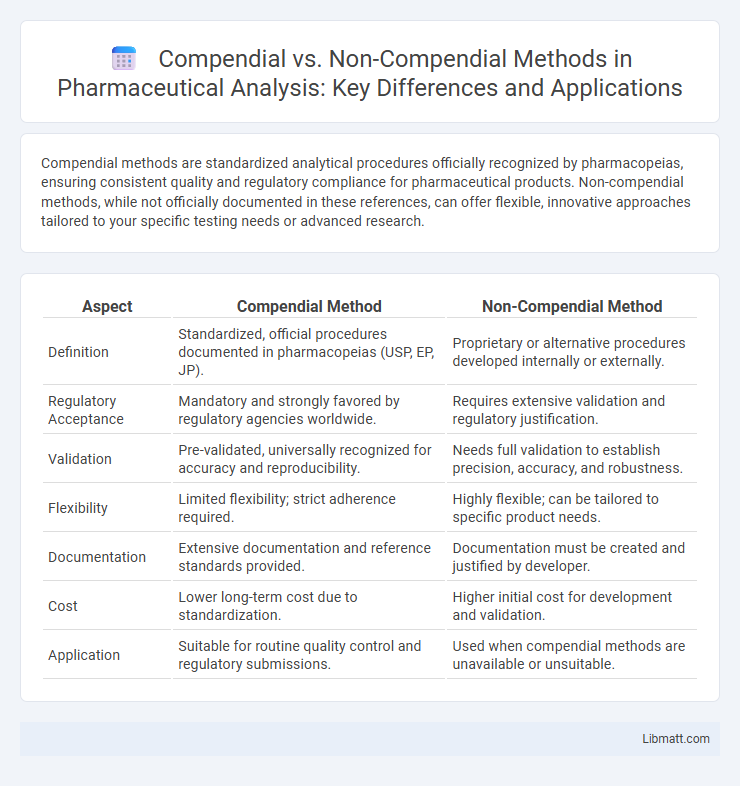Compendial methods are standardized analytical procedures officially recognized by pharmacopeias, ensuring consistent quality and regulatory compliance for pharmaceutical products. Non-compendial methods, while not officially documented in these references, can offer flexible, innovative approaches tailored to your specific testing needs or advanced research.
Table of Comparison
| Aspect | Compendial Method | Non-Compendial Method |
|---|---|---|
| Definition | Standardized, official procedures documented in pharmacopeias (USP, EP, JP). | Proprietary or alternative procedures developed internally or externally. |
| Regulatory Acceptance | Mandatory and strongly favored by regulatory agencies worldwide. | Requires extensive validation and regulatory justification. |
| Validation | Pre-validated, universally recognized for accuracy and reproducibility. | Needs full validation to establish precision, accuracy, and robustness. |
| Flexibility | Limited flexibility; strict adherence required. | Highly flexible; can be tailored to specific product needs. |
| Documentation | Extensive documentation and reference standards provided. | Documentation must be created and justified by developer. |
| Cost | Lower long-term cost due to standardization. | Higher initial cost for development and validation. |
| Application | Suitable for routine quality control and regulatory submissions. | Used when compendial methods are unavailable or unsuitable. |
Introduction to Analytical Methods
Compendial methods refer to standardized analytical procedures officially recognized in pharmacopeias such as the USP, EP, or JP, ensuring consistent quality and regulatory compliance of pharmaceutical substances. Non-compendial methods are custom-developed approaches tailored for specific research or development needs, often employed when compendial methods are unavailable or insufficient. Both methods play critical roles in pharmaceutical analysis, with compendial methods providing validated benchmarks and non-compendial methods offering flexibility for novel or specialized testing.
Defining Compendial Methods
Compendial methods refer to standardized testing procedures officially recognized and published in pharmacopeias such as the USP, EP, or JP, ensuring consistency and regulatory compliance in pharmaceutical analysis. These methods provide validated protocols for quality control, including assays, identification, and impurity testing, which are critical for drug approval and market release. You rely on compendial methods to meet global regulatory expectations and guarantee the safety, efficacy, and quality of pharmaceutical products.
Understanding Non-Compendial Methods
Non-compendial methods refer to analytical techniques not officially described or standardized in pharmacopeias such as the USP, EP, or JP, but are developed or adopted for specific testing needs. These methods offer flexibility to address novel compounds, advanced technologies, or proprietary formulations that compendial methods may not cover. Ensuring your non-compendial method is thoroughly validated according to ICH guidelines is essential for accuracy, reliability, and regulatory compliance.
Regulatory Framework and Standards
Compendial methods adhere to established regulatory frameworks and standards defined by official pharmacopeias such as USP, EP, and JP, ensuring global compliance and consistent quality for pharmaceuticals. Non-compendial methods, while sometimes accepted by regulatory bodies, often require extensive validation and justification to meet criteria set forth by agencies like the FDA or EMA due to the lack of standardized reference. Regulatory frameworks prioritize compendial methods for product approval and quality control, but evolving technologies and specific product needs drive the integration of validated non-compendial approaches within regulatory submissions.
Key Differences Between Compendial and Non-Compendial Methods
Compendial methods are standardized analytical procedures officially recognized by pharmacopeias such as USP, EP, and JP, ensuring consistency and regulatory compliance in pharmaceutical testing. Non-compendial methods, however, are developed by individual laboratories or companies to address specific testing needs, offering flexibility but lacking official validation across regulatory bodies. Your choice between these methods impacts the reliability, acceptance, and validation requirements of analytical results in drug quality control.
Method Validation Requirements
Compendial methods require strict adherence to pharmacopeial standards with established protocols for method validation that ensure accuracy, precision, specificity, and reproducibility as outlined by USP, EP, or JP. Non-compendial methods demand tailored validation based on ICH Q2(R1) guidelines, including comprehensive risk assessment to justify the method's suitability for intended use. Both methodologies emphasize robust documentation and consistency but differ in regulatory acceptance and validation flexibility.
Advantages of Compendial Methods
Compendial methods provide standardized, validated procedures recognized globally by pharmacopeias like USP, EP, and JP, ensuring consistent quality and regulatory compliance. These methods facilitate easier approval processes and enhance reproducibility in analytical testing. Your use of compendial methods guarantees reliable, trustworthy results widely accepted by regulatory authorities and industry stakeholders.
Benefits and Limitations of Non-Compendial Methods
Non-compendial methods offer flexibility and innovation, allowing customization to meet specific analytical needs beyond standardized protocols. These methods can provide faster development times and adaptability for unique formulations or novel compounds, but they lack the rigor and universal acceptance of compendial standards. You should consider that non-compendial approaches may face regulatory scrutiny and require extensive validation to demonstrate reliability and accuracy.
Selection Criteria for Method Adoption
Selection criteria for adopting compendial versus non-compendial methods hinge on regulatory compliance, validation status, and intended application. Compendial methods, recognized by pharmacopeias such as USP, EP, or JP, provide standardized protocols ensuring reliability and acceptance by regulatory agencies. Non-compendial methods may be chosen for innovative formulations or specialized analyses when validated thoroughly and demonstrated to meet accuracy, precision, and robustness standards, aligning with Your product development goals.
Future Trends in Pharmaceutical Analytical Methods
Future trends in pharmaceutical analytical methods emphasize the integration of compendial and non-compendial approaches to enhance accuracy, efficiency, and regulatory compliance. Advanced techniques such as high-resolution mass spectrometry and spectroscopic methods are increasingly adopted in non-compendial methods to complement traditional compendial standards. The evolution towards hybrid analytical frameworks supports real-time monitoring, automation, and improved data analytics to accelerate drug development and ensure quality control.
Compendial method vs Non-compendial method Infographic

 libmatt.com
libmatt.com